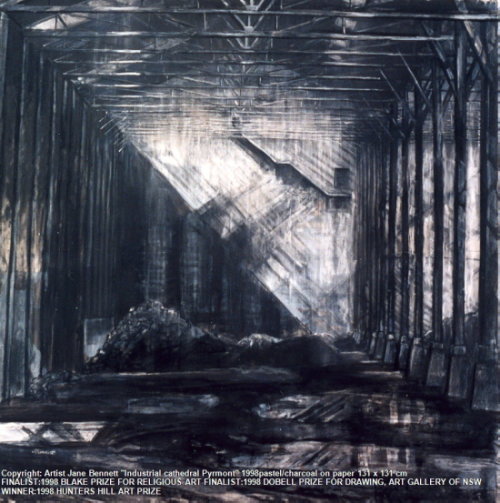 |
MP28 'Darling House' 2014 oil on canvas 51 x 41cm Available for sale |
About Me

- Jane Bennett Artist
- Sydney, NSW, Australia
- I'm an Industrial Heritage Artist who paints "en plein air".If it's damaged, derelict, doomed and about to disappear, I'll be there to paint it.
Saturday, 5 December 2015
Darling House, Millers Point- It's not dear it's darling
Saturday, 21 November 2015
Hotel Palisade redux
There's just so much history in the walls of the Palisade.
It was the scene of the last drinks for many Anzacs before they left Australia during the First World War, and the 'local' for the engineers and navvies working on the construction of the Sydney Harbour Bridge. Desperate wharfies seeking work at the Hungry Mile during the Great Depression would either drown their sorrows or celebrate their good fortune in finding a day's work, depending on luck. It was the haunt of 'colourful characters', the much loved centre of the Millers Point community and the headquarters of activists during the era of the Green Bans and the Patrick's dispute.
It stood on the corner of Argyle and Bettington streets in Millers Point like an exclamation point at the end of High street. For many years it was the tallest building in Sydney, and overlooked the wharves of East Darling Harbour which provided most of its clientele. At the time of its building, workers terraces to house the wharfies were being constructed in High Street which was carved into the sandstone escarpment above the Fingerwharves and Bond stores below.
This painting shows one of the landbridges over Hickson Road, and the railings preventing revellers falling into the deep cutting in front of the Palisade. This strange configuration of the landscape makes the quirky, slightly ramshackle style of the Palisade even more startling.
In 2014, when I painted this canvas, there was a small park in front of the Palisade. It was overgrown, but its figtrees were a welcome source of shade in summer. Since the redevelopment of this area, the park is now a wide green lawn with a few saplings which will need a lot of time before they provide shade.
MP7A Hotel Palisade 2014
oil on canvas 36 x 46cm
Available
There had been an earlier, much smaller hotel built on this site in the 1880s but it was pulled down in the frenzy of slum clearances at the beginning of the 20th century.
After the end of the bubonic plague crisis in the first decade of the 20th century, the population in Millers Point increased so much that the Sydney Harbour Trust had to build replacement hotels to cater to the port workers. Henry Deane Walsh was commissioned to build the new Palisade Hotel, one of 4 that were built by the Trust, the others being Dumbarton Castle, the 'Big House' (Moretons in Sussex Street- now the Sussex Hotel) and the Harbour View Hotel. 
MP30 The Reopening of the Palisade
2015 oil on canvas 51 x 25cm
Enquiries about similar paintings
The 5 storey hotel was built in 1915-16, and was one of the last Sydney buildings to be designed in the 'Federation Free' style, with parapets, and sandstone banding decorating the red brick masonry.
From the 1920s the head lease for the hotel was owned by Tooth and Co. who sub let it to various licensees.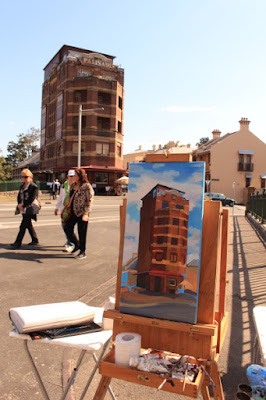
MP30 The Reopening of the Palisade
2015 oil on canvas 51 x 25cm
Enquiries about similar paintings
From
1936, when the role of the Sydney Harbour Trust was taken over by the
newly formed Maritime Service Board, title to the hotel was issued to
the MSB, although Tooths continued to lease it until 1950. At that time
the licensee, P. K. Armstrong, obtained the lease.
In February 1987 title passed from the MSB into private ownership, then in 1994, Palisade Properties Pty Ltd obtained title.

MP30 The Reopening of the Palisade
2015 oil on canvas 51 x 25cm

MP30 The Reopening of the Palisade
2015 oil on canvas 51 x 25cm
Thursday, 29 October 2015
Sydney Sandstone - Painting the Lands Department building
Unfortunately, this will soon change.
I don't know whether all the original features which makes this building so wonderful will be retained, but I thought that I should attempt to paint it while it is still in its original state.
I managed to set up my easel in Macquarie Place Park, directly opposite the corner of Bridge and Gresham street.
2015 oil on canvas 31 x 31cm
Enquiries
 |
| U235'Statues of Explorers', Lands Department 2015 oil on canvas 31 x 31cm Enquiries |
 |
| U235'Statues of Explorers', Lands Department 2015 oil on canvas 31 x 31cm Enquiries |
The clock tower has a copper onion-shaped dome which was allegedly influenced by the shape of the water carafe of Sir Henry Parkes.
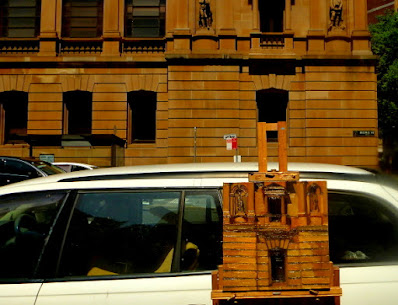 |
| U235'Statues of Explorers', Lands Department 2015 oil on canvas 31 x 31cm Enquiries |
 |
| U235'Statues of Explorers', Lands Department 2015 oil on canvas 31 x 31cm Enquiries |
 |
| U235'Statues of Explorers', Lands Department 2015 oil on canvas 31 x 31cm Enquiries |
In my painting the statue of the botanist Sir Joseph Banks is on the left, and the statue of the explorer Sturt on the right.
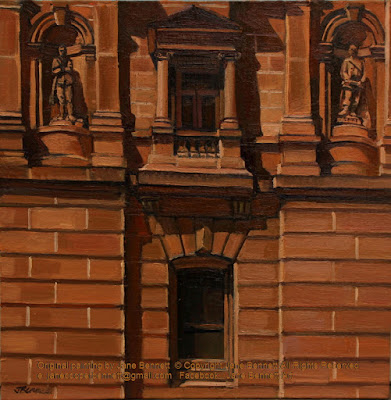 |
| U235'Statues of Explorers', Lands Department 2015 oil on canvas 31 x 31cm Enquiries |
To protect the building from unsympathetic development, a Permanent Conservation Order was passed by the NSW Heritage Council.
However, although it is one of the most beautiful and historic buildings in Australia, it still faces an uncertain future.
Both Sydney’s historic
The hotel will open in 2021 after the government employees finally leave in 2018.
Monday, 26 October 2015
In the Shadows- Painting the Justice and Police Museum
So, in the spirit of this event, I decided to paint one of Sydney's most beautiful sandstone buildings.
Although it was difficult, bordering on the impossible,I managed to set up an easel and paint 'en plein air' right in the heart of the CBD.
 | ||
| Plein air painting of the "Justice and Police Museum" 2015 oil on canvas 13 x 18cm |
 | |||
|
The complex had remained in use as a police station as late as 1985, when the area was a busy legal hub.
Today the museum tells the story of the seamy side of Sydney’s past.
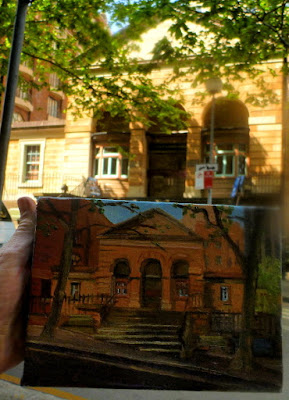 | |||
|
Behind the elegant facade lurk dingy 1890s holding cells, offices, charge room and courts. A century of underworld Sydney is contained inside.
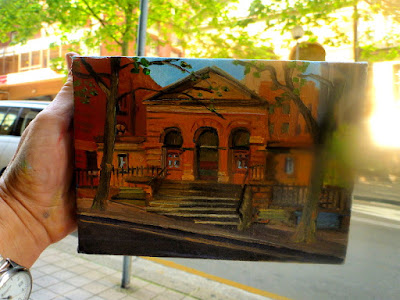 | |||
|
 | |||
|
Saturday, 26 September 2015
Sign of the Palisade

MP7 Sign of the Palisade 2014
acrylic on canvas 10 x 10cm
Available for sale
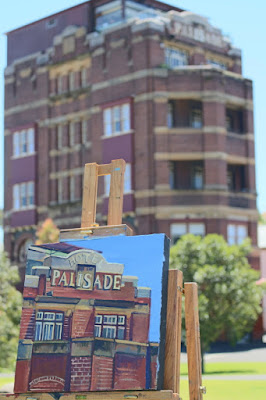 |
| MP39 'Sign of the Palisade' 2014 oil on canvas 31 x 31cm Available for sale |

